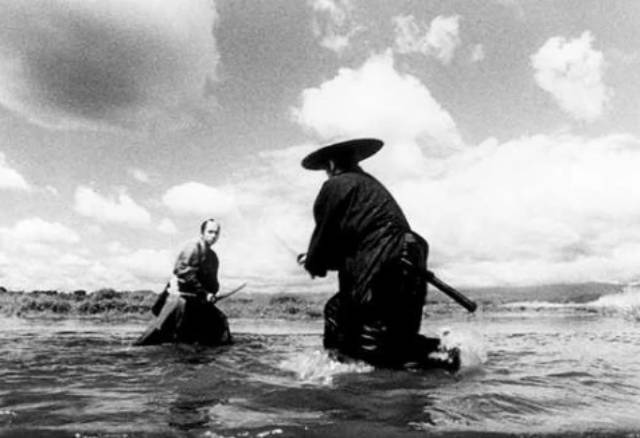
"Musashi Miyamoto" is a 1954 Japanese film directed and co-written by Hiroshi Inagaki, starring Toshiro Mifune. It is the first film in Inagaki's Samurai Trilogy of historical adventures. The film is adapted from Eiji Yoshikawa's novel "Musashi," originally serialized in the Japanese newspaper Asahi Shimbun from 1935 to 1939, and is loosely based on the life of the famous Japanese swordsman Miyamoto Musashi.
The film was followed by "Samurai II: Duel at Ichijoji Temple" (1955) and "Samurai III: Duel at Ganryu Island" (1956). It won a Special/Honorary Award at the 1955 Academy Awards for Outstanding Foreign Language Film.
The story begins after the Battle of Sekigahara, with Takezo (Toshiro Mifune) and his friend Matahachi (Rentarō Mikuni) on the losing side. Instead of the grand victory and glory Takezo had anticipated, he finds himself a hunted fugitive, burdened with the task of aiding a severely injured Matahachi. The pair seek shelter with a widow and her daughter, who are secretly connected to local brigands. When the brigands arrive to demand tribute from the women, Takezo fights them off. Both women try to seduce Takezo, but he rejects them. The widow then falsely accuses Takezo of assaulting her, convincing Matahachi to escort her and her daughter to Kyoto, despite his love and betrothal to Otsu (Kaoru Yachigusa) from his village.
Believing Matahachi has deserted him, Takezo returns home, injuring several men at a roadblock on the way. He informs Matahachi's family of his survival but refuses to explain his absence. Matahachi's mother, disbelieving, sets a trap for Takezo, leading to her arrest for treason along with many clan members. Despite a village-wide search organized by the local lord, Takezo evades capture.
Meanwhile, Otsu receives a letter from the widow, claiming Matahachi has gone off with her, leaving Otsu heartbroken. Matahachi's mother insists that Otsu is still her daughter-in-law, forcing her to live with her.
Takezo is eventually captured by the Buddhist priest Takuan Sōhō, who convinces the lord to let him handle Takezo's reform. Despite escaping with Otsu's help, Takezo is recaptured when he tries to rescue her from Himeji Castle. The priest tricks him into a three-year confinement, telling him to study the ways of the samurai to earn his release while Otsu waits safely in a hiding place.
The film concludes with Takezo's release and his granting of the samurai name "Musashi Miyamoto." He leaves to seek enlightenment, leaving two messages for Otsu: "Soon I will be back" and "Forgive me."
See also
-
Tatara Samurai

One day, bandits raid the quiet Tatara village, renowned for its steelworks and sword craftsmanship. Despite the arrival of samurai to protect the villagers, young Gosuke's mother is tragically killed while fleeing with him.
-
Samurai Fiction

Samurai Fiction is a 1998 samurai-comedy film directed by Hiroyuki Nakano. The movie stands out for being filmed almost entirely in black-and-white, paying homage to classic jidaigeki samurai films. However, what sets it apart from its inspirations, including the works of Akira Kurosawa, is its modern twist, notably Tomoyasu Hotei's rock-and-roll soundtrack. A loose spinoff, Red Shadow, was released in 2001.
-
Rurouni Kenshin

Rurouni Kenshin: Meiji Swordsman Romantic Story (Japanese: Hepburn: Rurōni Kenshin -Meiji Kenkaku Roman Tan-) is a Japanese manga series created by Nobuhiro Watsuki. Set in 1878, during the 11th year of the Meiji era in Japan, the story follows a former assassin known as Hitokiri Battosai. After his role in the turbulent Bakumatsu period, he adopts the identity of Himura Kenshin, a wandering swordsman who vows never to kill again. He dedicates his life to protecting the people of Japan. Watsuki crafted this series with the intent to create a unique shōnen manga, distinguishing it with a protagonist who is a former assassin and a narrative that becomes increasingly serious as it progresses.
-
Samurai Spy

Samurai Spy (Ibun Sarutobi Sasuke), also known as Spy Hunter, is a 1965 film directed by Masahiro Shinoda, adapted from a novel by Koji Nakada. The film follows the legendary ninja Sasuke Sarutobi as he hunts the elusive spy Nojiri, while a shadowy figure named Sakon leads a group of men with their own designs on Nojiri. As the pursuit unfolds, the lines between allies and enemies blur, leaving everyone unsure of each other's true allegiance. Created during the height of the Cold War, the movie reflects the complexities and shifting loyalties of spies caught in the power struggles of their era.
-
Samurai III: Duel at Ganryu Island

Samurai III: Duel at Ganryu Island (Japanese: Hepburn: Miyamoto Musashi Kanketsuhen: Ketto Ganryūjima) is a 1956 Japanese film directed by Hiroshi Inagaki and starring Toshiro Mifune. Filmed in Eastmancolor, it serves as the concluding chapter of Inagaki's Samurai Trilogy.
-
Samurai Marathon

The producing team behind Takashi Miike's "13 Assassins," Jeremy Thomas and Toshiaki Nakazawa, reunite for another visually striking and action-packed samurai film. Based on a novel by Akihiro Dobashi, this film may not reach the same heights of relentless carnage or critical acclaim as its predecessor, but it still offers an exciting and occasionally humorous addition to the samurai genre, likely to resonate with festival audiences. This story of a literal running battle between rival samurai factions could see moderate success in theaters, though it may require more marketing effort without the ultra-violent appeal that made "13 Assassins" memorable.
-
Samurai II: Duel at Ichijoji Temple (1955)

Duel at Ichijoji Temple (Hepburn: Zoku Miyamoto Musashi: Ichijōji no Kettō) is a 1955 Japanese film directed by Hiroshi Inagaki and starring Toshiro Mifune. Filmed in Eastmancolor, it is the second installment in Inagaki's Samurai Trilogy.
-
The Samurai I Loved (Semishigure)

The costumes, settings, and script of The Samurai I Loved immediately transport samurai film enthusiasts back to the golden era of classic black-and-white samurai masterpieces.

